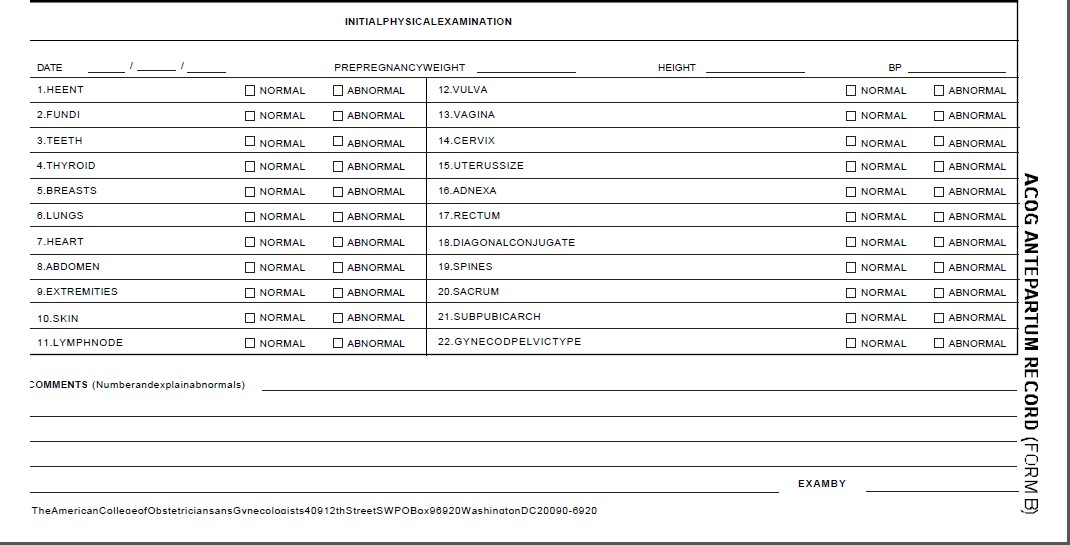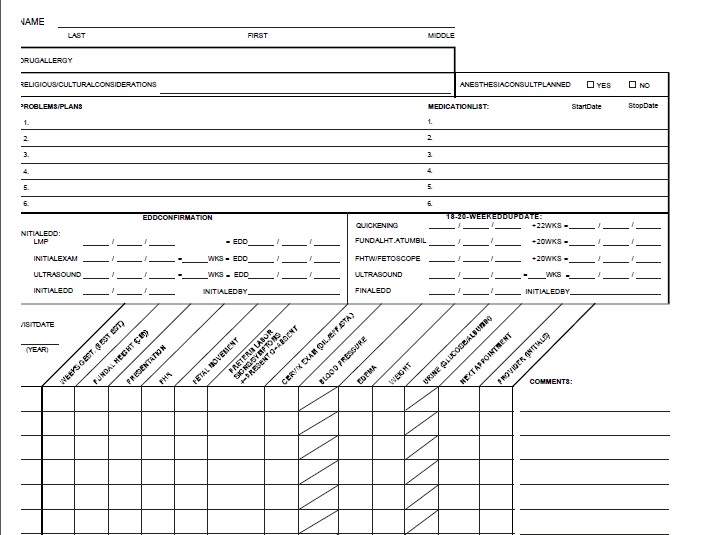Protocol - Total Pregnancy Weight Gain - Abstracted From Prenatal Charts
Description
There are several research contexts in which this information could be collected, and how the information is collected will vary depending on the context and availability of related information.
Weight gain during pregnancy is commonly monitored as a part of prenatal care. Total weight gain is calculated at the end of pregnancy (typically the last prenatal visit before delivery, and usually within 1 week of delivery) based on information abstracted from prenatal charts.
Specific Instructions
None
Availability
This protocol is freely available; permission not required for use.
Protocol
Total Weight Gain Abstracted from Prenatal Charts
Most obstetric practices and prenatal clinics use a standardized form to chart prenatal course. The American Congress of Obstetricians and Gynecologists (ACOG, formerly the American College of Obstetricians and Gynecologists) has an Antenatal Record form that is periodically upgraded and available for its members. There are others, such as the POPRAS (Problem Oriented Perinatal Risk Assessment System) forms, which are also in common use. All of the standardized forms have places or spaces to report information on gestational age, pre-pregnancy weight, height, and weights measured during pregnancy at every prenatal visit and dates of examination. For women carrying a singleton fetus, the expected schedule of prenatal visits suggested by ACOG is monthly through the 7th month (28 weeks), every 2-3 weeks through the 9th month (36 weeks), and weekly thereafter until delivery.
Total gestational weight gain is calculated by subtracting the pre-pregnancy weight from the weight at the final prenatal visit, usually within a week of delivery. Weight is occasionally measured at delivery and can be used for this calculation if membranes are still intact at the time of weighing. The weight at delivery can be found in the labor and delivery chart along with the gestational age at delivery.
The information to be abstracted from the records would be a) weight at final prenatal visit (to the nearest 100 g, e.g., 59.1 kg); b) date of final visit; c) pre-pregnancy weight; d) height; e) gestational age at final visit; f) gestational age at delivery.
An example of the relevant section of the ACOG Antenatal Record Form B (Initial Physical Exam) which charts date of exam, pre-pregnancy weight, and height:

Gestational age (written with both weeks and days, e.g., 39 weeks and 0 days or 39 + 0) is calculated using the best obstetrical EDD based on the following formula:
Gestational Age = (280 - (EDD - Reference Date))/ 7
An example of the relevant section of the ACOG Antenatal Record Form C which contains the date of the woman’s last menstrual period (LMP) and estimated due date(s) (EDD) for establishing (or correcting) gestational age at each prenatal visit:

Personnel and Training Required
For the aspects of the measures requiring chart review, the abstracter should be trained in medical terminology and records review; for measuring weights, the examiner should be trained as for Measured Weight. If measure is conducted by computer-assisted personal interviewing (CAPI), interviewer trained in CAPI administration is required; otherwise, no training is required for the paper-and-pencil interviewing (PAPI).
Equipment Needs
Computer (for computer-assisted personal interviewing [CAPI]); paper and-pencil (for paper-and-pencil interviewing [PAPI]).
Requirements
| Requirement Category | Required |
|---|---|
| Major equipment | No |
| Specialized training | No |
| Specialized requirements for biospecimen collection | No |
| Average time of greater than 15 minutes in an unaffected individual | No |
Mode of Administration
Medical record abstraction and/or physical measurement
Lifestage
Pregnancy
Participants
Women who have had a pregnancy (20 weeks or longer) or are currently pregnant.
Selection Rationale
Weight gain in pregnancy is associated with pregnancy outcomes, and there are recommended ranges of total weight gain depending on pre-pregnancy body mass index (BMI). Women who gain outside these recommendations (too low or too high) are at increased risk of delivering a low and high birth weight (i.e., small-for-gestational age [SGA] and large-for-gestational age [LGA] newborns), respectively. Risk for preeclampsia, gestational diabetes, and cesarean delivery are influenced by weight gain. Excess maternal weight gain during pregnancy, especially among those women who were normal weight before pregnancy, has also been independently associated with risk of overweight and obesity in the offspring.
Language
English, Spanish
Standards
| Standard | Name | ID | Source |
|---|---|---|---|
| caDSR Form | PhenX PX021302 - Total Pregnancy Weight Gain Abstracted From Prenatal C | 5805961 | caDSR Form |
Derived Variables
Total Weight Gain in Pregnancy
Process and Review
The Expert Review Panel #1 reviewed the measures in the Anthropometrics, Diabetes, Physical Activity and Physical Fitness, and Nutrition and Dietary Supplements domains.
Guidance from the ERP includes:
• Changed name of measure
• Added a new protocol
• New Data Dictionary
Protocol Name from Source
American Congress of Obstetricians and Gynecologists (ACOG), Antenatal Record Forms B and C, 2014
Source
American Congress of Obstetricians and Gynecologists (ACOG). (2014). Antenatal Record Forms B and C. Washington, DC: Author.
Certification for the Spanish translation can be found here.
General References
Institute of Medicine, Committee to Reexamine IOM Pregnancy Weight Guidelines. (2009). Weight gain during pregnancy: Reexamining the guidelines. K. M. Rasmussen & A. L. Yaktine (Eds). Washington, DC: National Academy Press.
Rasmussen, K. M., Catalano, P. M., & Yaktine, A. L. (2009). New guidelines for weight gain during pregnancy: What obstetrician/gynecologists should know. Current Opinion in Obstetrics and Gynecology, 21, 521-526.
Protocol ID
21302
Variables
Export Variables| Variable Name | Variable ID | Variable Description | dbGaP Mapping | |
|---|---|---|---|---|
| PX021302_TotalWeight_PrenatalCharts_Date_Final_Visit | ||||
| PX021302020000 | What is the date of the final visit? | N/A | ||
| PX021302_TotalWeight_PrenatalCharts_Gestational_Age_Delivery | ||||
| PX021302040000 | What is the patient's gestational age at delivery? | N/A | ||
| PX021302_TotalWeight_PrenatalCharts_Gestational_Age_FinalVisit | ||||
| PX021302030000 | What is the patient's gestational age at more | N/A | ||
| PX021302_TotalWeight_PrenatalCharts_Patient_Height | ||||
| PX021302060000 | What is the patient's height? | Variable Mapping | ||
| PX021302_TotalWeight_PrenatalCharts_Prepregnancy_Weight | ||||
| PX021302050000 | What is the patient's pre-pregnancy weight? | Variable Mapping | ||
| PX021302_TotalWeight_PrenatalCharts_Weight_First_Visit | ||||
| PX021302010000 | What is the patient's weight at final more | N/A | ||
Measure Name
Total Pregnancy Weight Gain
Release Date
October 1, 2015
Definition
Total change in weight of the participant over the course of pregnancy for the most recent pregnancy.
Purpose
The total pregnancy weight measure is used to assess the individual’s gestational weight gain in the current or past pregnancy and/or evaluate total weight gain with respect to recommendations for total weight gain based on pre-pregnancy body mass index (BMI, kg/m2).
Keywords
Anthropometrics, weight, body mass index (BMI), gestational diabetes, birth weight, PRAMS
Measure Protocols
| Protocol ID | Protocol Name |
|---|---|
| 21301 | Total Pregnancy Weight Gain - Self-Reported Weight Gain |
| 21302 | Total Pregnancy Weight Gain - Abstracted From Prenatal Charts |
| 21303 | Total Pregnancy Weight Gain - Weight Measured During Gestation |